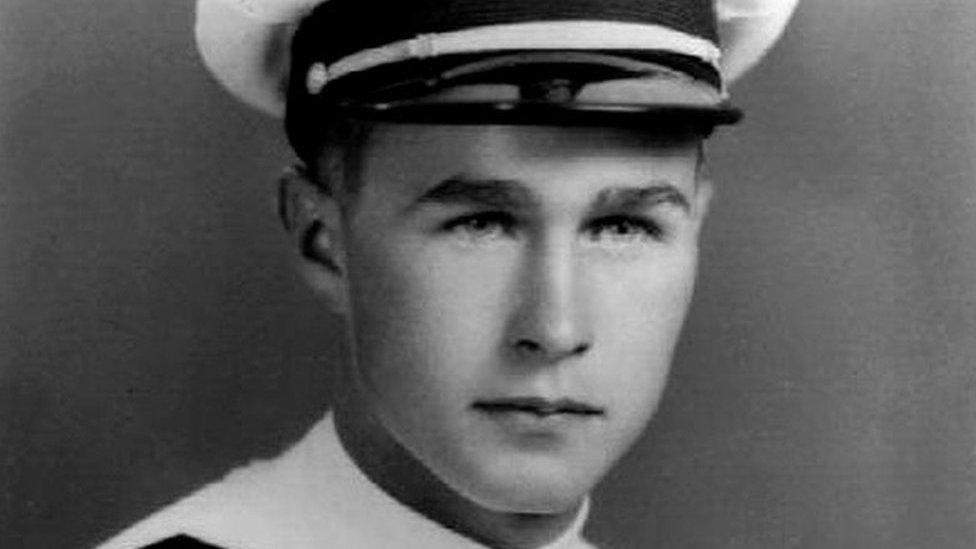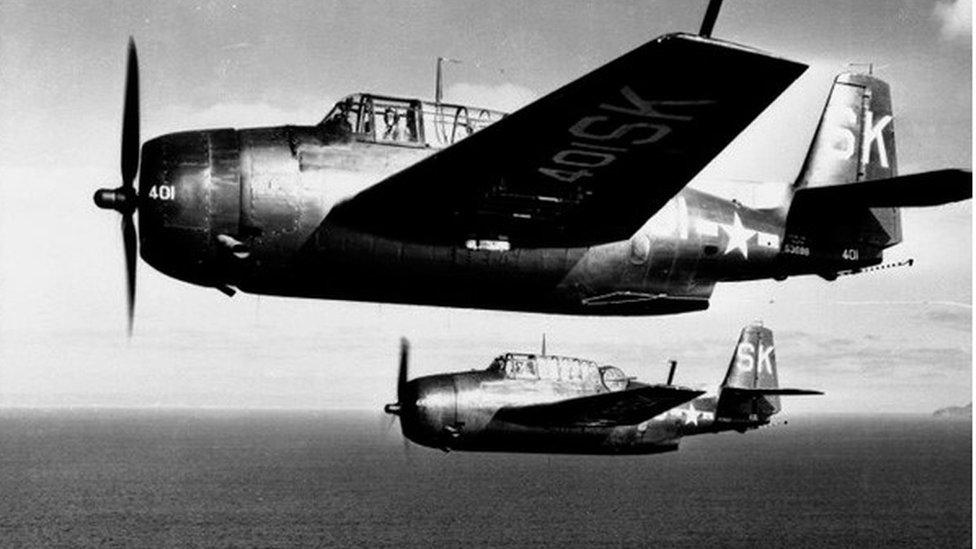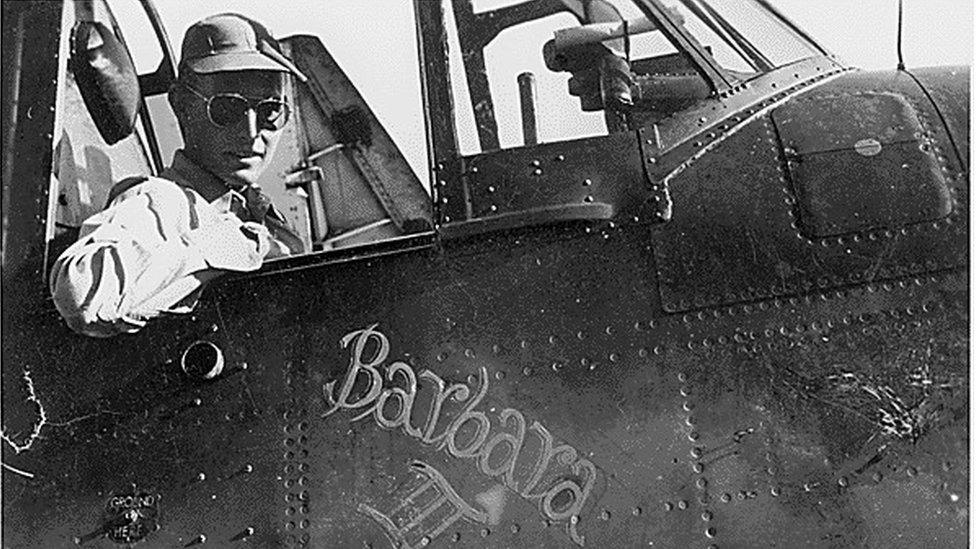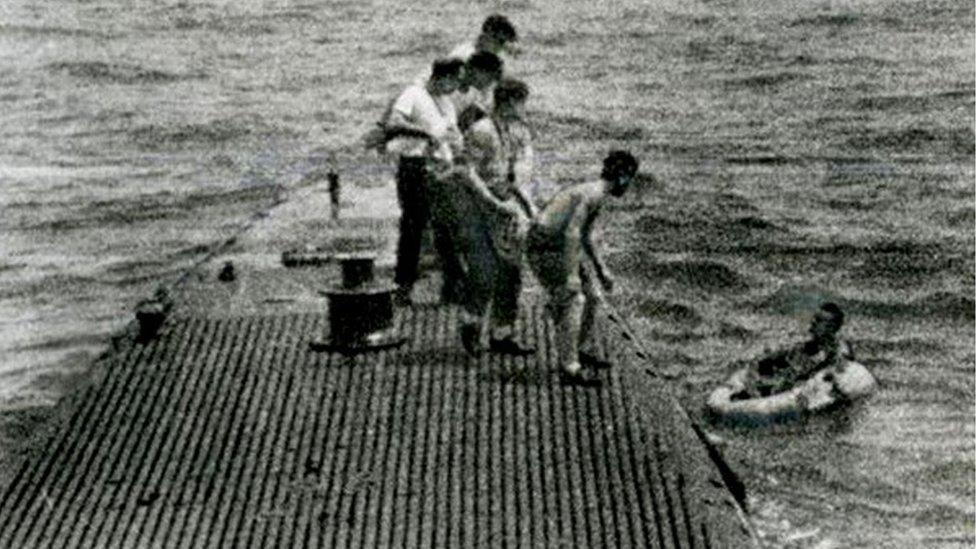George H W Bush: The war years
- Published

George H W Bush was not the first US president to have seen active service in wartime. But he was unique in having his exploits captured on film after ditching his aircraft in the Pacific in 1944.
A number of presidents have seen the face of battle. George Washington, the American colonies' commander-in-chief during the War of Independence, famously led his troops across the Delaware River in the bows of a rowing boat.
Besides this, both Ulysses S Grant and Dwight D Eisenhower commanded US forces and Teddy Roosevelt led the Rough Riders as they charged up San Juan Hill during the Spanish American War.
And John F Kennedy directed the crew of his motorboat to safety after it was rammed and sunk by a Japanese destroyer in the Pacific during World War II.
During the same conflict, in another part of that vast ocean, a 20 year-old US Navy aviator was winning himself the Distinguished Flying Cross. George Herbert Walker Bush would later describe his experience of war as "sobering".
Bush enlisted in the Navy on 13 June 1942, the day after his 18th birthday. The Japanese attack on Pearl Harbor had happened six months earlier and he had just graduated from the exclusive Andover College.
After completing 10 months of pre-flight training at the University of North Carolina, George Bush was commissioned as an ensign in the US Naval Reserve on 9 June 1943. He was, at the time, the youngest pilot in the US Navy.

He flew 58 missions over the Pacific
Three months later he was posted to the Pacific as a photographic officer with Torpedo Squadron VT-51, before moving to the light aircraft carrier, USS San Jacinto, in the spring of 1944.
Bush's move to the carrier coincided with one of the bloodiest campaigns of the war. As Japanese forces were rolled back across the northern Pacific, US troops had to "island hop" their way forward, often sustaining huge losses in the process.
After seeing action in the Marcus and Wake islands, Bush was involved in one of the largest air battles of the whole war over the Marianas islands in June 1944.
On 19 June, the US task force finally won out over the tenacious Japanese. Returning from the mission, he had to make a forced landing on water.
Attack
He and his crew were rescued by the destroyer, USS Clarence K Bronson, losing their aircraft in the process. And, six days later, Bush and another pilot were credited with sinking a small cargo ship.
On 1 August 1944 Bush was promoted to Lieutenant Junior Grade as the USS San Jacinto commenced operations against the Japanese in the Bonin Islands, 600 miles south-west of Japan.
On 2 September 1944, Bush piloted one of four Avenger light bombers which were to attack a Japanese radio station on the island of Chi Chi Jima.

He saw action in one of the war's largest air battles
During their attack, the four aircraft encountered intense anti-aircraft fire. While starting his bombing run, Bush's aircraft was hit and his engine caught fire.
He completed his attack and released the bombs, hitting and damaging the target. "We were trained to complete our runs no matter what the obstacle," he later commented.
The aircraft, though, was severely damaged and, with its engine blazing, Lieutenant Bush flew several miles out to sea before he and one crew member bailed out.
Unfortunately, this man died after his parachute failed to open. The third member of the crew was also lost.
Casualties
Bush landed in the sea and waited for four hours in an inflatable life-raft, while several US fighter aircraft circled protectively overhead, before being rescued by the lifeguard submarine, USS Finback.
As he later quipped: "I saw this thing coming out of the water and I said to myself, 'Jeez, I hope it's one of ours.'"
The rescue was filmed by the submarine's sub-lieutenant and featured in a number of Bush's political campaigns. His opponents often criticised the move but his campaign teams always gave their blessing to the use of the footage.

He as pulled from the seas by the crew of a US submarine
For his part in this action, Bush received one of his country's highest awards, the DFC. He remained on the USS Finback for a month, during which the submarine came under repeated attack from Japanese destroyers, and helped to rescue a number of other pilots.
Bush returned to the San Jacinto in November 1944 and saw action over the Philippines. Within months, though, Bush's squadron, half of whose pilots had become casualties, returned to the United States.
During his short and sharp war, George Bush flew 58 combat missions and, besides the DFC, received three Air Medals and the Presidential Unit Citation awarded to the USS San Jacinto.
Bush himself became a flight instructor before being honourably discharged from active duty in September 1945.
Though he had not served for a decade, Bush finally formally resigned from the US Navy in 1955. By then, after having graduated from Yale, he had already become a successful Texas oilman with political aspirations.